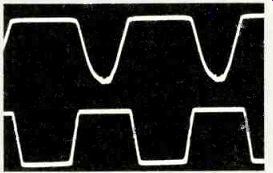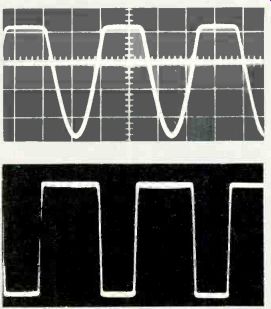By Wayne Lemons, CET
Audio-amplifier gain can be estimated by an electronic technician who touches his finger to the input connection and listens for hum or buzz from the speaker. This short cut technique has been used for more than 50 years and continues to be a valid test in many cases where only a good/bad indication is sufficient. Audible buzz proves the following stages have sufficient gain; but a lack of buzz indicates a defect has eliminated the gain.
Infallible test?
One technician had used the buzz test for years without making diagnostic mistakes and he believed it was an infallible method. However, all tests have limitations, as the technician soon learned when a transistorized public-address system was brought to the shop for repair.
After the bottom shield was re moved, the tech touched his finger to the mic jack's hot lug. A loud buzz came from the test speaker indicating normal gain. But when he plugged in the microphone and spoke into it, no sound came from the test speaker even at maximum gain setting.
Bad mic, plug or cable
The technician now assumed that the mic, cable or plug was defective. But no sound came from a test mic when it was substituted. Reasoning that the jack might be shorting to ground only when the mic plug was inserted, he searched for shorts and opens by using the ohmmeter range of a VOM. There were no opens or shorts (either with a mic plugged in or without it), and the wiring was correct.
The technician reviewed the procedure and repeated the tests. But the conclusion was the same-the amplifier worked normally except with a microphone.
Better tests
Up to this point, the technician had diagnosed efficiently by performing simple, but appropriate, tests. The buzz test indicated a dead microphone, but replacement of it disproved that possibility. If the tech then either had given up or had shot-gunned the input stages, he would have wasted much time and learned nothing.
Fortunately, this technician guessed correctly that a limitation of the buzz test was responsible for the ambiguous, conclusions, and he went on to the next level of more-precise tests.
His troubleshooting ESP guided him to the first transistorized stage, the microphone preamplifier. Dc-voltage measurements first to be performed, and they revealed abnormal conditions. Voltage at the collector (see schematic) was equal to the supply voltage and the base voltage was almost zero. These dc voltages proved the transistor was non-conducting because of insufficient forward bias. This stage should have had zero gain. How did the buzz pass through? Curiosity caused the technician to measure the dc voltages during a repeat of the buzz test. With his finger touching the input lug and a buzz coming from the speaker, the base voltage measured about-1Vdc, and the collector reading was about half of the supply voltage. During the buzz test, the transistor was conducting and amplifying. Those voltages hinted that the buzz signal was acting as bias for the transistor, thus permitting amplification. But unexplained was the question of why the microphone signal was ignored rather than being used as bias, also.
Use theory either before or afterwards
When the total picture is confused, a good rule for troubleshooting is to follow all known discrepancies or symptoms. Often this will lead to finding the bad component, and then the theory can be reviewed later.
Therefore, the technician investigated the source of the insufficient base bias. He disconnected the base ends of R1 and R2 and measured their resistances. R2 was within tolerance, but R1 had increased to more than 7 M-o . A new resistor restored proper microphone volume.

---------- WHICH COMPONENT IS BAD?
Explanation
Current between collector and emitter in a silicon transistor is zero for all reversed-bias voltages, and it also is zero for forward-bias voltages of less than 0.5V (dc or peak).
Only forward bias of more than 0.5V produces significant amounts of C/E current and gain.
A 60Hz signal of several volts can be transferred to a high-impedance amplifier input by ungrounded fingers. During positive peaks this signal acts as strong forward bias, thus saturating the transistor with maximum collector current. The negative peaks are reversed bias which eliminates all collector cur rent. Therefore, the buzz-test (collector) output signal is a series of strong pulses.
The signal level of most public address microphones is about 1-mV.
Suppose the forward bias of the malfunctioning transistor is 0.15V.
Adding the 1 mV signal increases the bias to only 0.16V on positive peaks. This is far below the conduction threshold. The transistor remains cut off, no signal is at the collector, and no microphone sounds reach the speaker.
All of the confusion and wrong symptoms would have been prevented if the technician had applied a .01V signal from an audio generator to the microphone input.
Moral: The buzz test for gain can cause gross errors when applied to amplifier inputs that normally are supplied with less than about 0.1V of signal.
-----------
Details of buzz tests
Tests by hum or buzz are possible because an ungrounded human body picks up a significant amount of 60Hz power signal by capacitance action from surrounding electrical wiring. Amplitudes of more than 200VPP have been measured with an ungrounded scope when the low-capacitance probe was grasped firmly between thumb and finger. Less-firm connections reduced the variable amplitude. When a 1-M-o resistor was used as a load, the signal dropped to about 75VPP. The low-resistance load of a transistor would lower the signal even more, although the reduced amplitude is sufficient for a buzz test.
Results were very different when the scope was grounded by the third prong of the ac plug. Only about 1VPP could be obtained by finger connections. About 5VPP was obtained from a 15-ft wire. With an ungrounded scope the measurement had been 100VPP.
Tubes vs. transistors Accuracy of the buzz test varies according to the total amplifier gain and the impedance of the input. Loudest buzz volume is obtained from high gain amplifiers having high-impedance inputs. Therefore, a larger percentage of tube amplifiers fulfill these qualifications than the solid-state versions do.
For example, an input for ceramic phonograph record cartridge has an input resistance of 500,000 ohm or higher and the amplifier gain is sufficient for full output with about 0.5V RMS at the input. These amplifiers provide a loud buzz regardless of whether they have tubes or transistors.
Tube circuits of two or more stages produce a satisfactory buzz during tests. However, a single power-output transistor might not produce a buzz because of the low input impedance. Many audio stages in TVs have sufficient gain for a dependable buzz test.
Another variable is that the buzz volume depends on the amplifier grounding. Different results are obtained when one side of the ac line is bypassed to ground with a capacitor than when both sides are bypassed or if a single capacitor is connected between the ac inputs.
However, for most tests there is more than enough amplitude of 60Hz signal to drive the amplifier into distortion. This distortion is the reason why the test signal sounds as a raw buzz rather than a smooth hum (as it would with a pure sine wave of that frequency).
Waveform examples Figure 1 shows actual waveforms obtained by grasping the base lead of the transistor in the previous circuit. The amplitude was not stable, making detailed analysis and sharp traces very difficult to obtain.
Therefore, a second set of waveforms was simulated (Figure 2). The Figure 2A waveform shows base-signal clipping that begins at +0.6V above the zero-voltage line. Current from the forward bias between base and emitter produces the line of clipping marks where transistor amplification begins. This analysis is proved by the collector waveform of Figure 2B.
Comments
In most applications, the buzz test of amplifier gain is practical and dependable. However, question the results if they do not agree with other allied tests. Go on to instrument analysis if there is doubt about the accuracy of any buzz test.

Figure 1 Top scope trace is the base waveform with part of the positive
peak clipped by transistor base current during an actual buzz test in
the previous circuit. Collector waveform (lower trace) is a near-square
wave because the finger hum at the base was strong.

Figure 2 (A) To obtain a stable waveform, a sine-wave generator was
used during a simulated buzz test.
Scope gain was 0.5V/division, so the zero-voltage line shows no base conduction until +0.6V. Base current then clipped the sine wave. This base current in turn produced collector/ emitter current. (B) The collector waveform was almost a square wave, with the positive peaks reaching the +8V-supply level during negative base peaks (cut-off bias) and the negative peaks reaching saturation at about +0.1V during positive base signal.
Also see: